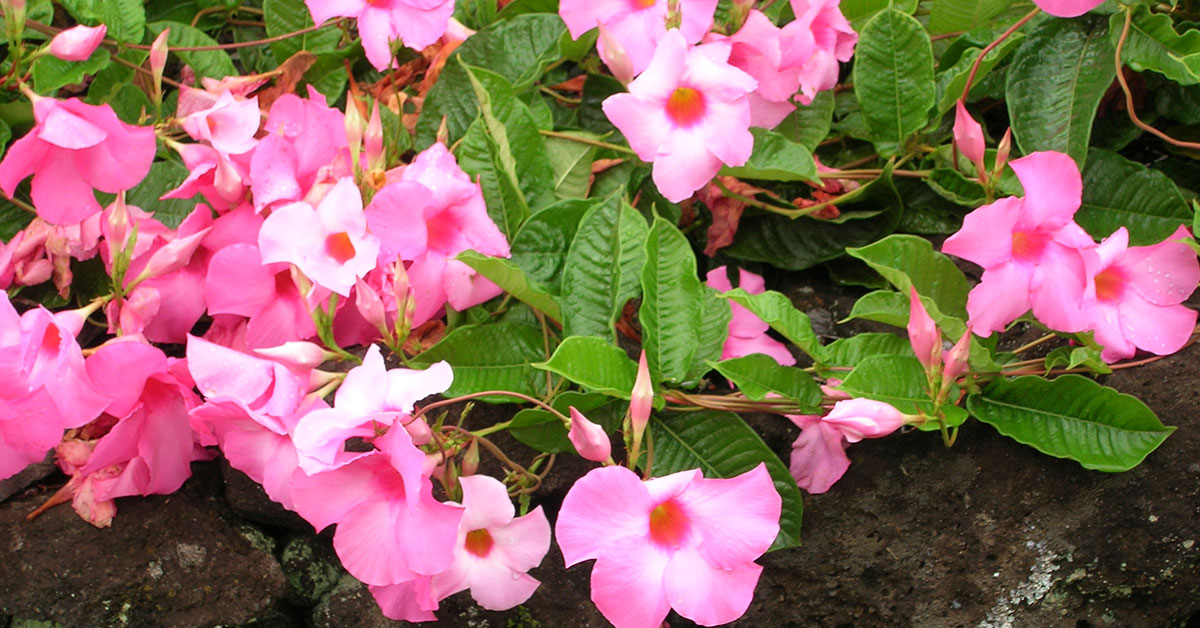Mandevilla, which is sometimes called rocktrumpet, is a flowering perennial vine when grown in hardiness zones 10 and 11. In cooler climates, it grows as an annual. Gardeners like keeping this vine because of the stunning, pink flowers with yellow centers that the vine produces. All plants can experience health problems, just like us. One of the more common problems that gardeners experience is their Mandevilla leaves turning yellow.
What causes Mandevilla leaves to turn yellow and how to treat it
A few Mandevilla leaves turning yellow, particularly toward the base of your vine, isn’t really much cause for concern. But if many leaves are being impacted, it’s best to begin going down the checklist of possible causes from most likely to least.
Poor watering
The biggest cause of yellowing Mandevilla leaves is improper and inconsistent watering. If you don’t provide enough water, your Mandevilla leaves can dehydrate and begin to die. If you provide too much water or don’t allow the water to properly drain from the soil, it can cause the roots to get soggy and experience root rot. One of the symptoms of root rot is yellowing leaves.
To fix this problem, move your Mandevilla into a pot with proper drainage and good, well-draining soil. If it’s planted in the ground, try reducing the amount of water you give it, depending on how dry or soaked the soil seems. It may be that you’re providing too much or too little water.
Too much or too little fertilizer
If your plant doesn’t have enough nutrients in order to perform vital biological functions, it will fail to thrive, which is one reason Mandevilla leaves start to turn yellow. If you haven’t been fertilizing your plant and it’s been in the same pot for a while, it may be time to provide it with fertilizer.
Conversely, if you overfertilize your Mandevilla plant, this can cause its leaves to turn yellow through a process often called fertilizer burn. Fertilizer burn occurs when too much nutrients are present in the plant’s soil, which interferes with its ability to uptake the proper amount of nutrients. Excess nitrogen can burn and destroy root systems as well, resulting in inadequate water being taken into the plant. If you’ve recently fertilized your Mandevilla plant and its leaves are starting to turn yellow, this may be what’s happening. Give your plant a thorough watering and remove any excess fertilizer from the soil.
Diseases
Mandevilla leaves can be destroyed due to diseases as well. Southern Wilt, Ralstonia solancearum, is a bacterial disease that most commonly causes this problem. The sad news here is that this disease will eventually kill your Mandevilla. It is best to completely remove the plant and soil from your garden in order to prevent the spread of Southern Wilt to other plants.
Pests
Mandevilla is suseptible to three primary pest insects: mealybugs, spider mites, and aphids. Fortunately, these pests can be easily killed off of your plants by using neem oil. Neem oil is my personal favorite for dealing with pests, but insecticidal soaps can be deployed too if the neem oil isn’t fixing the problem. Using either neem oil or an insecticidal soap will help to remove the eggs and juviniles of these pests as well as the adults.
Aging leaves
Finally, another cause for yellowing Mandevilla leaves is simply an indication that the leaves are aging. Leaves are fragile things that don’t last forever, and having some leaves turn yellow and die off isn’t an unusual thing. Old growth dies back to free up energy and resources for the development of new growth.













